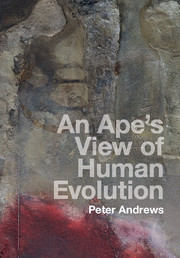Crossref Citations
This Book has been
cited by the following publications. This list is generated based on data provided by Crossref.
Baldwin, Mary K.L.
Balaram, Pooja
and
Kaas, Jon H.
2017.
The evolution and functions of nuclei of the visual pulvinar in primates.
Journal of Comparative Neurology,
Vol. 525,
Issue. 15,
p.
3207.
Kaas, Jon H.
2017.
Evolution of the Brain, Cognition, and Emotion in Vertebrates.
p.
59.
Whittaker, J.E.
and
Parfitt, S.A.
2017.
The Archaeological and Forensic Applications of Microfossils: A Deeper Understanding of Human History.
p.
9.
Martins, Jo. M.
Guo, Fei
and
Swanson, David A.
2018.
Global Population in Transition.
p.
1.
Clarke, Ronald J.
2019.
Encyclopedia of Global Archaeology.
p.
1.
Nakatsukasa, Masato
2019.
Spinal Evolution.
p.
73.
Clarke, Ronald J.
2020.
Encyclopedia of Global Archaeology.
p.
5244.
Johnson, R. J.
Stenvinkel, P.
Andrews, P.
Sánchez‐Lozada, L. G.
Nakagawa, T.
Gaucher, E.
Andres‐Hernando, A.
Rodriguez‐Iturbe, B.
Jimenez, C. R.
Garcia, G.
Kang, D.‐H.
Tolan, D. R.
and
Lanaspa, M. A.
2020.
Fructose metabolism as a common evolutionary pathway of survival associated with climate change, food shortage and droughts.
Journal of Internal Medicine,
Vol. 287,
Issue. 3,
p.
252.
Andrews, P.
and
Johnson, R.J.
2020.
Evolutionary basis for the human diet: consequences for human health.
Journal of Internal Medicine,
Vol. 287,
Issue. 3,
p.
226.
Michel, Lauren A.
Lehmann, Thomas
Mcnulty, Kieran P.
Driese, Steven G.
Dunsworth, Holly
Fox, David L.
Harcourt‐Smith, William E.H.
Jenkins, Kirsten
Peppe, Daniel J.
and
Kwiecien, Ola
2020.
Sedimentological and palaeoenvironmental study from Waregi Hill in the Hiwegi Formation (early Miocene) on Rusinga Island, Lake Victoria, Kenya.
Sedimentology,
Vol. 67,
Issue. 7,
p.
3567.
Carn, David
Lanaspa, Miguel A.
Benner, Steven A.
Andrews, Peter
Dudley, Robert
Andres‐Hernando, Ana
Tolan, Dean R.
and
Johnson, Richard J.
2021.
The role of thrifty genes in the origin of alcoholism: A narrative review and hypothesis.
Alcoholism: Clinical and Experimental Research,
Vol. 45,
Issue. 8,
p.
1519.
Almécija, Sergio
Hammond, Ashley S.
Thompson, Nathan E.
Pugh, Kelsey D.
Moyà-Solà, Salvador
and
Alba, David M.
2021.
Fossil apes and human evolution.
Science,
Vol. 372,
Issue. 6542,
Clarke, Ronald J.
Pickering, Travis Rayne
Heaton, Jason L.
and
Kuman, Kathleen
2021.
The Earliest South African Hominids.
Annual Review of Anthropology,
Vol. 50,
Issue. 1,
p.
125.
Domínguez‐Rodrigo, Manuel
2022.
Savannas, human evolution, and only in Africa.
Evolutionary Anthropology: Issues, News, and Reviews,
Vol. 31,
Issue. 2,
p.
103.
Bobe, René
and
Wood, Bernard
2022.
Estimating origination times from the early hominin fossil record.
Evolutionary Anthropology: Issues, News, and Reviews,
Vol. 31,
Issue. 2,
p.
92.
Johnson, Richard J.
Sánchez‐Lozada, Laura G.
Nakagawa, Takahiko
Rodriguez‐Iturbe, Bernardo
Tolan, Dean
Gaucher, Eric A.
Andrews, Peter
and
Lanaspa, Miguel A.
2022.
Do thrifty genes exist? Revisiting uricase.
Obesity,
Vol. 30,
Issue. 10,
p.
1917.
Peppe, Daniel J.
Cote, Susanne M.
Deino, Alan L.
Fox, David L.
Kingston, John D.
Kinyanjui, Rahab N.
Lukens, William E.
MacLatchy, Laura M.
Novello, Alice
Strömberg, Caroline A. E.
Driese, Steven G.
Garrett, Nicole D.
Hillis, Kayla R.
Jacobs, Bonnie F.
Jenkins, Kirsten E. H.
Kityo, Robert M.
Lehmann, Thomas
Manthi, Fredrick K.
Mbua, Emma N.
Michel, Lauren A.
Miller, Ellen R.
Mugume, Amon A. T.
Muteti, Samuel N.
Nengo, Isaiah O.
Oginga, Kennedy O.
Phelps, Samuel R.
Polissar, Pratigya
Rossie, James B.
Stevens, Nancy J.
Uno, Kevin T.
and
McNulty, Kieran P.
2023.
Oldest evidence of abundant C
4
grasses and habitat heterogeneity in eastern Africa
.
Science,
Vol. 380,
Issue. 6641,
p.
173.
MacLatchy, Laura M.
Cote, Susanne M.
Deino, Alan L.
Kityo, Robert M.
Mugume, Amon A. T.
Rossie, James B.
Sanders, William J.
Cosman, Miranda N.
Driese, Steven G.
Fox, David L.
Freeman, April J.
Jansma, Rutger J. W.
Jenkins, Kirsten E. H.
Kinyanjui, Rahab N.
Lukens, William E.
McNulty, Kieran P.
Novello, Alice
Peppe, Daniel J.
Strömberg, Caroline A. E.
Uno, Kevin T.
Winkler, Alisa J.
and
Kingston, John D.
2023.
The evolution of hominoid locomotor versatility: Evidence from Moroto, a 21 Ma site in Uganda.
Science,
Vol. 380,
Issue. 6641,





